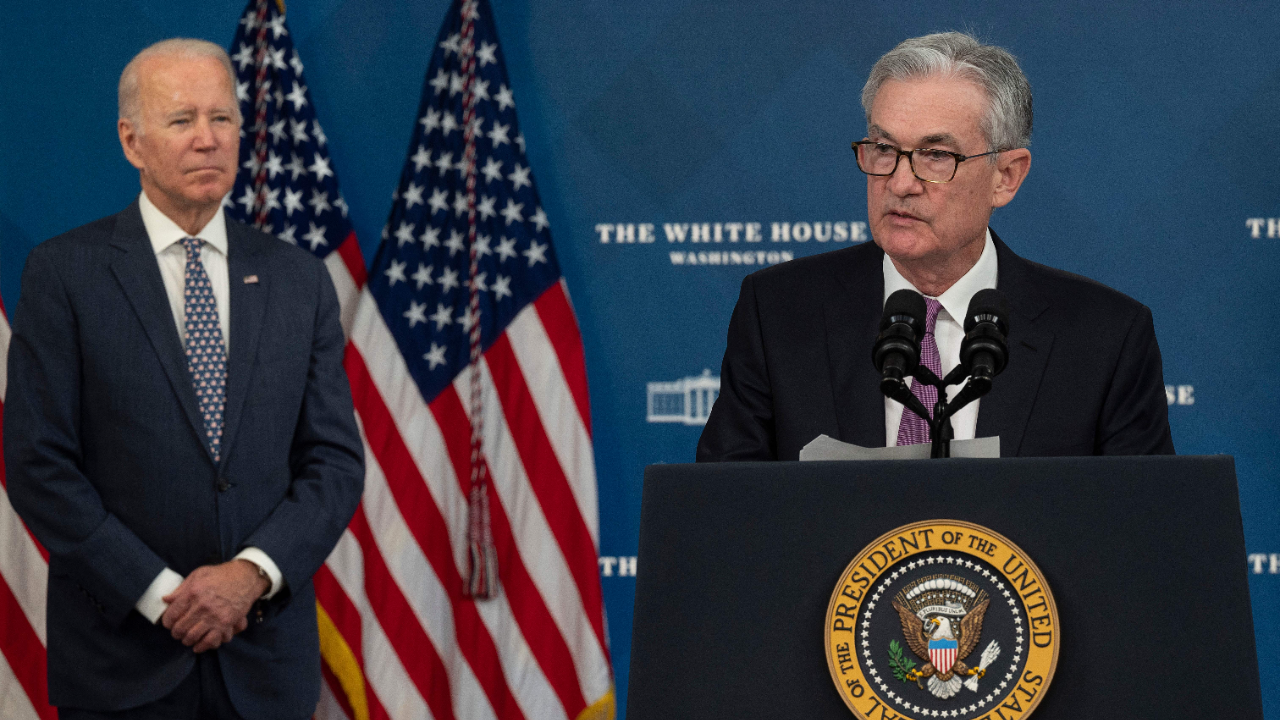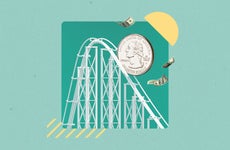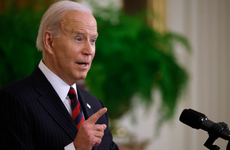The worst inflation in 40 years: Here’s when price pressures could hit their peak

The Bankrate promise
At Bankrate we strive to help you make smarter financial decisions. While we adhere to strict , this post may contain references to products from our partners. Here's an explanation for .
Consumers in 2021 were promised a light at the end of the tunnel as they endured month after month of decades-high inflation on almost everything — from cars, gasoline and utilities, to housing, food and clothing.
But hope for relief is quickly fading, as supply chains remain mangled, labor markets grow increasingly tighter and prices keep ratcheting higher, so much that they rose in January to levels not seen since February 1982. The conflict between Russia and Ukraine could have secondary effects that drive up prices on energy, oil, raw materials and other commodities even more.
“I’ve been a real inflation hawk for the last year or so, and no one would listen,” recalls Gary Zimmerman, CEO of MaxMyInterest, a cash management platform for consumers. “You cannot print $5 trillion dollars of new money, inject it into the economy and expect no impact. You have to think differently in an inflationary environment, and we need to be prepared for the fact that this inflation is not transitory.”
Part of the fear is that prices in motion tend to stay in motion. Vehicle insurance, for example, is getting more expensive because the price of used cars, tires, parts and medical care are rising. Landlords are increasing rent amid record demand and soaring utility costs, and workers are asking for higher pay to keep up. High inflation begets high inflation when companies then pass along those higher labor costs to consumers.
The Fed’s fight against higher inflation
Inflation is already spreading to service-based sectors, particularly in shelter costs, which contributed nearly one-fifth to inflation’s gain between December and January 2021.
That also points to a noisy few months for inflation data. Prices could cool in some sectors and heat up in others, reflecting lags in how inflation manifests. All of that makes it more difficult to tell whether and when inflation has truly hit its peak.
“If people expect inflation in the future, they will behave differently in the current, and that is how inflation in many cases can go from being temporary to more permanent,” says Brent Schutte, chief investment strategist at Northwestern Mutual. “When it becomes more permanent is when people think it will be more permanent.”
Markets, lawmakers and President Joe Biden are calling on the Federal Reserve to intervene. Officials are likely going to make it more expensive to borrow money at their next rate-setting meeting in March, and they’re also expected to signal that it’s the first in a long line of “steady” hikes this year.
Those cumulative rate increases could take interest rates back to 2019 levels, while officials’ plans to stop growing the money supply by mid-March should also tap harder on the economy’s brakes.
“The economy no longer needs or wants the very highly accommodative policies that we’ve had in place to deal with the pandemic and the aftermath,” Fed Chair Jerome Powell told lawmakers during a January hearing. “It is really time for us to begin to move away from those emergency pandemic settings to a more normal level.”
Economists see inflation peaking as pandemic eases, but may still hold higher for longer
Some price increases may still indeed prove to be temporary. Energy, transportation and goods have been some of the biggest catalysts for inflationary pressures over the past 12 months, a direct consequence of supply shortages and the pandemic. Once companies find workarounds, bottlenecks clear and the virus abates even more, prices in those corners of the economy could settle back down.
Inflation could level off at about 3 percent, according to Ryan Sweet, senior director of economic research at Moody’s Analytics. Sweet formulated that number by eliminating various threads in the global supply chain web. Audio, video, new and used cars are contributing 2.5 percentage points to overall inflation, he estimates, while soaring energy costs are adding another 2 percentage points.
If that plays out, inflation would end up higher than what Fed officials most recently estimated in December 2021, when they penciled in inflation on a downward trajectory toward 2.6 percent in 2023 and 2.1 percent in 2024.
“I don’t think we’re rushing into this new inflation regime where 5, 6, 7 percent inflation is the norm,” Sweet says. “An aging population, globalization, technology — these are all still disinflationary in the medium term.”
Still, that’s almost two times higher than the inflation consumers have been used to experiencing. Price pressures averaged at 1.7 percent in the years between the end of the Great Recession and the beginning of the coronavirus pandemic. Recent inflation is costing the average household $276 extra dollars a month, Sweet estimates.
A mismatch between supply and demand is also partly to blame for today’s levels of high inflation.
Flush with cash from pandemic-era aid, consumers purchased cars, homes, furniture and other items, rather than the vacations, meals out at restaurants or concerts and sporting events tickets they would’ve purchased in nonpandemic times.
Labor shortages have made it hard to keep up. Job openings, for example, have held near record highs for the past 11 months, yet employers have struggled to fill those vacant positions as the worker pool holds pre-pandemic levels. That might mean the economy is running too hot right now.
“We’re not above our ultimate potential, but we’re probably operating above our sustained potential given where supply constraints are at,” says Marc Goldwein, senior vice president and senior policy director for the Committee for a Responsible Federal Budget. “The trade off is, when the Fed raises interest rates, it’s going to slow GDP [gross domestic product] and job growth compared to where job growth otherwise would be — at the expense of controlling inflation.”
Russia’s invasion of Ukraine further pressures oil prices
Russia’s invasion of Ukraine is another wrinkle for U.S. consumers. The country is a relatively minor U.S. trading partner, yet the interconnectedness of global supply chains that have already been roiled in the aftermath of the coronavirus pandemic could exacerbate those inflationary pressures. Russia exports billions of dollars worth of wheat, coal, oil and natural gas to China, as well as other countries throughout Europe, including the Netherlands, Belarus, Germany and Italy, according to the Observatory of Economic Complexity, an online trade data hub.
Russia’s dominance as a global oil and natural gas producer could also bring consumers even more pain at the pump, at least temporarily. Global oil prices topped $105 a barrel in trading Thursday on the news, the highest level since 2014.
The conflict evokes memories of the 1973 oil crisis when Arab members of the Organization of Petroleum Exporting Countries (OPEC) imposed an embargo on the U.S., adding upward pressure on inflation and contributing to an almost two-decade-long spiral.
Experts say the U.S. economy is much less sensitive today to swings in oil prices, but the extent of the impact depends on how long the conflict lasts and what level of sanctions are put in place.
After imposing steep penalties that limit Russia’s biggest banks and companies from western financial support, President Biden said in a nationwide address Thursday that the U.S. plans to tap its oil reserves as necessary to limit gas prices from surging even more.
“Expect more of what we’ve seen in recent weeks with commodity prices rising, particularly oil and wheat,” says Greg McBride, CFA, Bankrate chief financial analyst. “These higher prices will lead to further production by producers that have been reluctant to add capacity back too fast amid COVID uncertainty.”
Fed will have to juggle risks when raising interest rates
How fast the Fed raises rates depends, in part, on the scope of the geopolitical conflict in Ukraine.
Officials have so far hoped to steer a soft landing of the U.S. economy, tiptoeing between starting a recession by raising rates too quickly and causing the economy to overheat by keeping rates too low.
“The Fed is betting that if it keeps its foot on the gas, that’s going to blow up in its face,” the CFRB’s Goldwein says. “You may get lower unemployment in the near term, but higher inflation is eating away at peoples’ wages and peoples’ incomes. Given that unemployment is at 4 percent and inflation is at 7 percent, it’s pretty clear where the problem is in the economy.”
Raising rates will put downward pressure on inflation, but so will abating supply chain and virus concerns. Removing too much stimulus — and all at once — might risk needlessly keeping more Americans out of work and slowing down the economy.
The Fed’s toolkit is also limited in how much it can address both geopolitical tensions and supply chain woes. Officials can only cool demand by making borrowing more expensive. That might prevent inflation from getting more entrenched in consumers’ and businesses’ expectations, causing more dangerous wage-price spirals, but it won’t unload cargo ships or produce more oil.
Conflict in Ukraine is unlikely to derail the Fed’s plans to hike rates in March, but it might cause the Fed to move much more slowly as it waits to see how the global and domestic economy evolves.
“The uncertainty is likely to lead the Fed to take a slower approach on rate hikes, not a faster one,” Bankrate’s McBride says. “They’ll want to be diligent about monitoring for any economic impact, so this tilts the scales in favor of a quarter-point, rather than half-point, hike in March.”
What to do with your money as inflation and uncertainty rises
Inflation is just adding an extra layer of economic uncertainty. Take steps with your finances now to prepare for rising rates — and mitigate your impact from a high-inflationary environment.
- Tune out volatility: Stocks have gotten off to a bumpy start this year as investors process the risks of higher inflation and an aggressive Fed, and markets remain volatile amid Russia’s invasion of Ukraine. If you’re a long-term investor, tune out the noise and stay focused on the bigger picture. Remember: The only way to lock in a loss is if you sell.
- Free up cash by refinancing: Mortgage rates have bounced from their pandemic-era lows, but homeowners might still be able to find an offer on the market that’s better than what they’re currently paying. Refinancing could potentially shave hundreds of dollars off your monthly payment, freeing up crucial cash in a high inflationary environment.
- Prepare your wallet for a recession: Given all of the risks facing U.S. consumers, think about recession-proofing your finances. During recessions, joblessness becomes more widespread. Ask yourself how you’d get by if you faced a temporary spell of unemployment. That can be by building up your emergency fund, as well as paying down debt, limiting expenses and living within your means.
- Diversify your portfolio: Experts say that higher inflation shouldn’t alter your strategy but should instead underscore a focus on diversifying your investments. That might include incorporating things like dividend-paying equities, real estate investment trusts (REITs) or Treasury-Inflation Protected Securities (TIPS) into your portfolio, as well as limiting your exposure to fixed-income investments, such as bonds.
Individuals who invest for the long-haul will undoubtedly have to grapple with periods of low inflation and high inflation.
“In this economic cycle, you’re not going to wake up every morning worried about deflation like in the last economic cycle,” Northwestern Mutual’s Schutte says. “You’re going to wake up every morning and wonder where we’re at on the inflation side. I don’t worry about too little; I worry about too much.”
Learn more:
Related Articles

Even after inflation cools, Americans could still be paying the price

Worried about surging inflation? Here’s how to protect your wallet from taking a big hit

How is the U.S. economy doing? With inflation hitting 40-year highs, watch these 4 key areas

Should you be worried about inflation? Here’s what the experts are saying